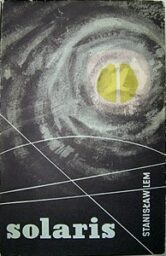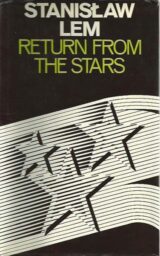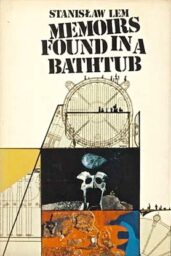
Polish author Stanisław Lem, one of the greatest science fiction writers of the 20th and possibly any other century, wrote three important novels in 1961: Solaris, Memoirs Found in a Bathtub, and Return from the Stars. Demonstrating his wide-ranging talents and interests, Lem explored what at first seem like very different themes in these three texts.
 Solaris is the best known of the three, thanks to multiple film versions and its worldwide ubiquity following at least a dozen translations. A novel of layers, Solaris is, on the surface, the story of an astronaut (Kris Kelvin) who arrives at a station on an alien planet to find that the scientists there seem to have lost their minds and are suffering from hallucinations. Kelvin himself soon begins to see his dead wife. Only later does he learn that those who preceded him have bombarded the single ocean covering the planet with high levels of radiation. Kelvin and the remaining scientists must come up with a plan to rid themselves of the phantoms and tell Earth about their experiences before they completely lose their minds. Another layer of Solaris involves extensive discussion of the decades of research that had been undertaken to understand the planet. Lem is known for this kind of in-depth chronicling of imaginary texts and theories—A Perfect Vacuum (1971; translated 1978) includes sardonic reviews of nonexistent books, while Imaginary Magnitude (1973; translated 1984) includes discussions of the nonexistent fields of “intellectronics” and “phantomatics.” Solaris, like His Master’s Voice (another of Lem’s novels), pushes us to acknowledge our inability, as humans, to ever truly think outside of our own consciousness.
Solaris is the best known of the three, thanks to multiple film versions and its worldwide ubiquity following at least a dozen translations. A novel of layers, Solaris is, on the surface, the story of an astronaut (Kris Kelvin) who arrives at a station on an alien planet to find that the scientists there seem to have lost their minds and are suffering from hallucinations. Kelvin himself soon begins to see his dead wife. Only later does he learn that those who preceded him have bombarded the single ocean covering the planet with high levels of radiation. Kelvin and the remaining scientists must come up with a plan to rid themselves of the phantoms and tell Earth about their experiences before they completely lose their minds. Another layer of Solaris involves extensive discussion of the decades of research that had been undertaken to understand the planet. Lem is known for this kind of in-depth chronicling of imaginary texts and theories—A Perfect Vacuum (1971; translated 1978) includes sardonic reviews of nonexistent books, while Imaginary Magnitude (1973; translated 1984) includes discussions of the nonexistent fields of “intellectronics” and “phantomatics.” Solaris, like His Master’s Voice (another of Lem’s novels), pushes us to acknowledge our inability, as humans, to ever truly think outside of our own consciousness.
 Return from the Stars, like Solaris, features an astronaut confronted by seemingly insurmountable obstacles. This time the astronaut, Hal Bragg, is faced with a society that has completely changed since he left on an expedition 127 years before (only 10 years for Bragg). The world he returns to has been changed by a process called “betrization” which has taken from humans the ability to kill. Now everyone is docile, polite, and uninterested in what Bregg brings them: knowledge of the stars.
Return from the Stars, like Solaris, features an astronaut confronted by seemingly insurmountable obstacles. This time the astronaut, Hal Bragg, is faced with a society that has completely changed since he left on an expedition 127 years before (only 10 years for Bragg). The world he returns to has been changed by a process called “betrization” which has taken from humans the ability to kill. Now everyone is docile, polite, and uninterested in what Bregg brings them: knowledge of the stars.
 The absurd Memoirs Found in a Bathtub can be read as an allegory about finding the meaning of life in a seemingly meaningless world. Without any knowledge about Lem’s life, one might read this novel simply as an example of the absurd, a black comedy about humanity’s existence as rats in a maze without point or meaning. Knowing about Lem’s experiences as a Jew, trying to survive during World War II in occupied Poland, adds an entirely new dimension to such a reading. The random and senseless violence the narrator witnesses in the corridors of “The Building,” the lies, the endless bureaucracy, the suicides, the fear—Lem and his family lived this. Memoirs was born from experience; the fact that the narrator has conversations and run-ins that are ridiculous and even humorous only underscores the tragic and terrifying nature of the story.
The absurd Memoirs Found in a Bathtub can be read as an allegory about finding the meaning of life in a seemingly meaningless world. Without any knowledge about Lem’s life, one might read this novel simply as an example of the absurd, a black comedy about humanity’s existence as rats in a maze without point or meaning. Knowing about Lem’s experiences as a Jew, trying to survive during World War II in occupied Poland, adds an entirely new dimension to such a reading. The random and senseless violence the narrator witnesses in the corridors of “The Building,” the lies, the endless bureaucracy, the suicides, the fear—Lem and his family lived this. Memoirs was born from experience; the fact that the narrator has conversations and run-ins that are ridiculous and even humorous only underscores the tragic and terrifying nature of the story.
What contemporary author reminds you most of Stanisław Lem? Are there qualities you would like to see more of his literary descendants emulate?

